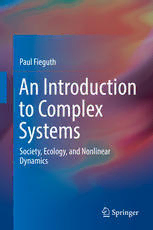Table Of ContentPaul Fieguth
An Introduction
to Complex
Systems
Society, Ecology, and Nonlinear
Dynamics
An Introduction to Complex Systems
Paul Fieguth
An Introduction to Complex
Systems
Society, Ecology, and Nonlinear Dynamics
123
PaulFieguth
FacultyofEngineering
UniversityofWaterloo
Waterloo
Ontario,Canada
ISBN978-3-319-44605-9 ISBN978-3-319-44606-6 (eBook)
DOI10.1007/978-3-319-44606-6
LibraryofCongressControlNumber:2016959761
©SpringerInternationalPublishingSwitzerland2017
Thisworkissubjecttocopyright.AllrightsarereservedbythePublisher,whetherthewholeorpartof
thematerialisconcerned,specificallytherightsoftranslation,reprinting,reuseofillustrations,recitation,
broadcasting,reproductiononmicrofilmsorinanyotherphysicalway,andtransmissionorinformation
storageandretrieval,electronicadaptation,computersoftware,orbysimilarordissimilarmethodology
nowknownorhereafterdeveloped.
Theuseofgeneraldescriptivenames,registerednames,trademarks,servicemarks,etc.inthispublication
doesnotimply,evenintheabsenceofaspecificstatement,thatsuchnamesareexemptfromtherelevant
protectivelawsandregulationsandthereforefreeforgeneraluse.
Thepublisher,theauthorsandtheeditorsaresafetoassumethattheadviceandinformationinthisbook
arebelievedtobetrueandaccurateatthedateofpublication.Neitherthepublishernortheauthorsor
theeditorsgiveawarranty,expressorimplied,withrespecttothematerialcontainedhereinorforany
errorsoromissionsthatmayhavebeenmade.
Printedonacid-freepaper
ThisSpringerimprintispublishedbySpringerNature
TheregisteredcompanyisSpringerInternationalPublishingAG
Theregisteredcompanyaddressis:Gewerbestrasse11,6330Cham,Switzerland
Preface
Although I had studied nonlinear dynamic systems, bifurcations, and bistable
systems as a graduate student, I had clearly never really absorbed the ideas at a
conceptuallevel,sinceitwastenyearslaterthatIwasstruckbyasimplefigureof
catastrophic nonlinearstate transitions in the contextof ecologicalsystems. I was
immediatelyhooked:theconceptwassoclear,soelegant,andsoeasytounderstand.
HowwasitpossiblethatIhadneverreallyencounteredthis?
OvertimeIbecameconvincedthatnotjustI,butindeedmostoftheundergrad-
uate studentswith whom I interact, fundamentallydo notgrasp the big picture of
theissuessurroundingthem,eventhoughtheunderlyingmathematicalconceptsare
wellwithinreach.Theunderlyingproblemisclear:forpedagogicalreasonsnearly
allofthecourseswhichmystudentstakefocusonmathematicsandsystemswhich
aresmallscale,linear,andGaussian.Unfortunately,thereisnotasinglelarge-scale
ecologicalorsocialphenomenonwhichisscalar,linear,andGaussian.
This is, very simply, the rationale for this text: to explore a variety of large
issues,globalwarming,iceages,water,andpoverty,andtomotivateandteachthe
materialofthecourse,nonlinearsystems, non-Gaussianstatistics, spatialsystems,
andcomplexsystems—motivatedbythesecasestudies.
The large-scale problems challenging the world are complex and multifaceted
andwillnotbesolvedbyasinglestrategy,academicfield,orperspective.Thisbook
cannot claim to teach how to solve such enormousproblems; however, the intent
isverymuchtodrawexplicitparallelsandconnectionsbetweenthemathematical
theory,ontheonehand,andworldissues/casestudiesontheother.
Thespecifictopicsbeingtaughtarenonlineardynamicsystems,spatialsystems,
power-law systems, complex systems, and inverse problems. To be sure, these
fields have been aroundfor some time, and many bookshave been written on the
subjects;however,thefieldsare,atbest,onlyweaklypresentinmostundergraduate
programs.
This bookis intendedforreadershavinga technicalbackground,such as engi-
neering,computerscience, mathematics, or environmentalstudies. The associated
coursewhichIhavetaughtisopentothirdandfourthyearundergraduatestudents;
however, this book should, I hope, be of interest and mostly accessible to a
v
vi Preface
significantly wider audience. The only actual prerequisites are some background
in algebra and in probability and statistics, both of which are summarized in the
appendices. The reader who would prefer to get a perspective of the text might
prefertofirstreadthetwooverviewchapters,onglobalwarminginChapter2and
onwaterinChapter12.
There are many online resources related to nonlinear dynamics and complex
systems;however,onlinelinkscanfrequentlychangeorbecomeoutdated,soIam
reluctant to list such links here in the text. Instead, I am maintaining a web page
associatedwiththisbook,at
http://complex.uwaterloo.ca/text
towhichthereaderisreferredforfurtherreadingandothermaterial.
A number of people were of significant support in the undertaking of this
textbook.Most significantly,I would like to thankmy wife, Betty Pries, who was
tirelessinherenthusiasmandsupportforthisprojectandregularlyarticulatedthe
value which she perceivedin it. My thanksto Professor Andrea Scott and Doctor
WernerFieguth,bothofwhomreadeverypageofthebookfrombeginningtoend
andprovideddetailedfeedback.AppreciationtoDoctorChristophGarbe,myhost
andresearchcollaboratorattheUniversityof Heidelberg,wheremuchofthistext
waswritten.
Teaching this material to students at the University of Waterloo has allowed
me to benefit from their creative ideas. Here, I particularly need to recognize the
contributionof the projectreports of Maria Rodriguez Anton (discountfunction),
VictorGan(cities),KirstenRobinson(resilience),DouglasSwanson(SOCcontrol),
andPatrickTardif(Zipf’slaw).
Finally,mythankstothecontributionsofmychildren:
• Anya,forallowingherartworktoappearinprintinFigureA.2
• Thomas,forposingatVersaillesandappearinginExample3.1
• Stefan,fordemonstratinganinvertedpenduluminFigure5.8
Waterloo,Ontario,Canada PaulFieguth
Contents
1 Introduction................................................................. 1
1.1 HowtoReadThisText............................................... 3
References.................................................................... 3
2 GlobalWarmingandClimateChange................................... 5
FurtherReading.............................................................. 12
References.................................................................... 12
3 SystemsTheory............................................................. 13
3.1 SystemsandBoundaries............................................. 14
3.2 SystemsandThermodynamics ...................................... 17
3.3 SystemsofSystems.................................................. 23
CaseStudy3:NutrientFlows,Irrigation,andDesertification............. 24
FurtherReading.............................................................. 34
SampleProblems ............................................................ 35
References.................................................................... 39
4 DynamicSystems........................................................... 41
4.1 SystemState.......................................................... 42
4.2 Randomness.......................................................... 46
4.3 Analysis............................................................... 48
4.3.1 Correlation.................................................. 48
4.3.2 Stationarity.................................................. 51
4.3.3 Transformations ............................................ 56
CaseStudy4:WaterLevelsoftheOceansandGreatLakes............... 58
FurtherReading.............................................................. 61
SampleProblems ............................................................ 62
References.................................................................... 65
5 LinearSystems.............................................................. 67
5.1 Linearity.............................................................. 68
5.2 Modes................................................................. 69
5.3 SystemCoupling..................................................... 73
vii
viii Contents
5.4 Dynamics............................................................. 75
5.5 ControlofDynamicSystems........................................ 81
5.6 Non-normalSystems................................................. 83
CaseStudy5:SystemDecoupling.......................................... 85
FurtherReading.............................................................. 90
SampleProblems ............................................................ 90
References.................................................................... 95
6 NonlinearDynamicSystems:Uncoupled ................................ 97
6.1 SimpleDynamics..................................................... 98
6.2 Bifurcations........................................................... 103
6.3 HysteresisandCatastrophes......................................... 108
6.3.1 CatastrophicStateTransition .............................. 110
6.3.2 SystemIrreversibilityandHysteresis...................... 111
6.4 SystemBehaviournearFolds........................................ 114
6.5 Overview.............................................................. 120
CaseStudy6:ClimateandHysteresis ...................................... 122
FurtherReading.............................................................. 128
SampleProblems ............................................................ 129
References.................................................................... 134
7 NonlinearDynamicSystems:Coupled................................... 135
7.1 Linearization.......................................................... 136
7.2 2DNonlinearSystems ............................................... 139
7.3 LimitCyclesandBifurcations....................................... 144
7.4 ControlandStabilization ............................................ 146
CaseStudy7:Geysers,Earthquakes,andLimitCycles ................... 151
FurtherReading.............................................................. 160
SampleProblems ............................................................ 161
References.................................................................... 167
8 SpatialSystems ............................................................. 169
8.1 PDEs.................................................................. 171
8.2 PDEsandEarthSystems............................................. 174
8.3 Discretization......................................................... 177
8.3.1 DiscretizationinTime...................................... 177
8.3.2 DiscretizationinSpace..................................... 179
8.4 SpatialContinuous-StateModels.................................... 181
8.5 SpatialDiscrete-StateModels ....................................... 192
8.6 AgentModels......................................................... 196
CaseStudy8:GlobalCirculationModels.................................. 199
FurtherReading.............................................................. 202
SampleProblems ............................................................ 203
References.................................................................... 210
Contents ix
9 PowerLawsandNon-GaussianSystems................................. 211
9.1 TheGaussianDistribution........................................... 213
9.2 TheExponentialDistribution........................................ 214
9.3 HeavyTailedDistributions........................................... 216
9.4 SourcesofPowerLaws .............................................. 225
9.5 SynthesisandAnalysisofPowerLaws ............................. 228
CaseStudy9:PowerLawsinSocialSystems.............................. 234
FurtherReading.............................................................. 238
SampleProblems ............................................................ 239
References.................................................................... 244
10 ComplexSystems........................................................... 245
10.1 SpatialNonlinearModels............................................ 246
10.1.1 PhaseTransitions........................................... 247
10.1.2 Criticality ................................................... 248
10.2 Self-OrganizedCriticality............................................ 253
10.3 Emergence............................................................ 256
10.4 ComplexSystemsofSystems ....................................... 257
CaseStudy10:ComplexSystemsinNature ............................... 262
FurtherReading.............................................................. 264
SampleProblems ............................................................ 265
References.................................................................... 269
11 ObservationandInference ................................................ 271
11.1 ForwardModels...................................................... 272
11.2 RemoteMeasurement................................................ 274
11.3 Resolution ............................................................ 278
11.3.1 MeasurementResolution................................... 278
11.3.2 StateResolution ............................................ 286
11.4 InverseProblems..................................................... 287
CaseStudy11A:Sensing—SyntheticApertureRadar ................... 299
CaseStudy11B:Inversion—AtmosphericTemperature................. 303
FurtherReading.............................................................. 305
SampleProblems ............................................................ 305
References.................................................................... 308
12 Water......................................................................... 309
12.1 OceanAcidification.................................................. 311
12.2 OceanGarbage....................................................... 312
12.3 Groundwater.......................................................... 313
CaseStudy12:SatelliteRemoteSensingoftheOcean.................... 316
FurtherReading.............................................................. 317
SampleProblems ............................................................ 318
References.................................................................... 318
x Contents
13 ConcludingThoughts ...................................................... 319
FurtherReading.............................................................. 320
References.................................................................... 321
Appendices
A MatrixAlgebra ............................................................. 325
FurtherReading.............................................................. 331
References.................................................................... 331
B RandomVariablesandStatistics.......................................... 333
FurtherReading.............................................................. 339
References.................................................................... 340
C NotationOverview.......................................................... 341
Index............................................................................... 343

